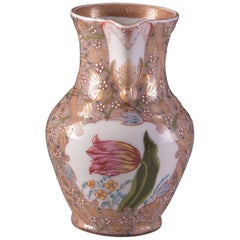Fischer Vilmos
Antique 1890s Hungarian Baroque Ceramics
Porcelain
Recent Sales
Antique Late 19th Century Hungarian Baroque Coffee and Cocktail Tables
Porcelain
People Also Browsed
Early 20th Century Italian Glass
Glass
Antique 1820s English Regency Dinner Plates
Porcelain
Late 20th Century French Empire Ashtrays
Porcelain
Vintage 1950s French Louis XVI Commodes and Chests of Drawers
Walnut
21st Century and Contemporary Italian Other Dinner Plates
Porcelain
Antique Late 19th Century French Belle Époque Planters, Cachepots and Ja...
Porcelain
Antique Early 1900s American Desks and Writing Tables
Oak
Antique 19th Century Austrian Regency Tea Sets
Ceramic, Porcelain
Mid-20th Century Italian Chandeliers and Pendants
Murano Glass
Antique Mid-19th Century English Porcelain
Pearlware
Vintage 1930s Czech Regency Glass
Gold
Vintage 1980s German Mid-Century Modern Serving Pieces
Porcelain
Antique Late 19th Century French Aesthetic Movement Porcelain
Porcelain
Antique 19th Century French Empire Porcelain
Porcelain, Paint
Antique Early 19th Century French Empire Porcelain
Porcelain
Vintage 1950s Czech Mid-Century Modern Chandeliers and Pendants
Steel
A Close Look at Baroque Furniture
The decadence of the Baroque style, in which ornate furnishings were layered against paneled walls, painted ceilings, stately chandeliers and, above all, gilding, expressed the power of the church and monarchy through design that celebrated excess. And its influence was omnipresent — antique Baroque furniture was created in the first design style that truly had a global impact.
Theatrical and lavish, Baroque was prevalent across Europe from the 17th to mid-18th century and spread around the world through colonialism, including in Asia, Africa and the Americas. While Baroque originated in Italy and achieved some of its most fantastic forms in the late-period Roman Baroque, it was adapted to meet the tastes and materials in each region. French Baroque furniture informed Louis XIV style and added drama to Versailles. In Spain, the Baroque movement influenced the elaborate Churrigueresque style in which architecture was dripping with ornamental details. In South German Baroque, furniture was made with bold geometric patterns.
Compared to Renaissance furniture, which was more subdued in its proportions, Baroque furniture was extravagant in all aspects, from its shape to its materials.
Allegorical and mythical figures were often sculpted in the wood, along with motifs like scrolling floral forms and acanthus leaves that gave the impression of tangles of dense foliage. Novel techniques and materials such as marquetry, gesso and lacquer — which were used with exotic woods and were employed by cabinetmakers such as André-Charles Boulle, Gerrit Jensen and James Moore — reflected the growth of international trade. Baroque furniture characteristics include a range of decorative elements — a single furnishing could feature everything from carved gilded wood to gilt bronze, lending chairs, mirrors, console tables and other pieces a sense of motion.
Find a collection of authentic antique Baroque tables, lighting, decorative objects and other furniture on 1stDibs.

